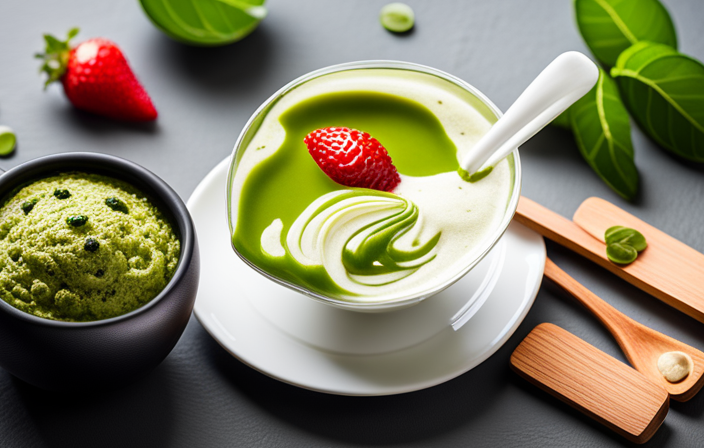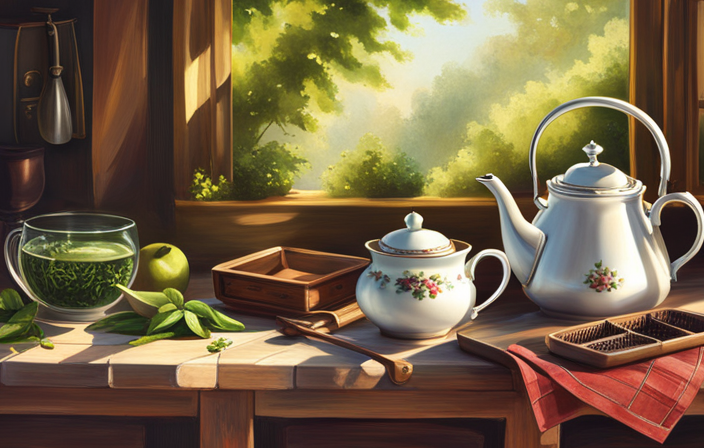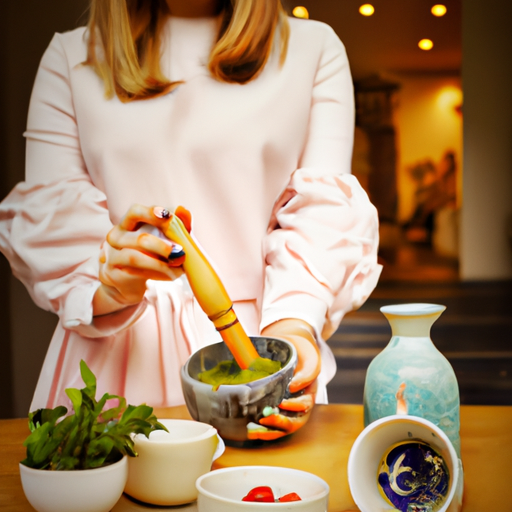Green Tea
10 Green Tea Recipes You Must Try: From Matcha Smoothies to Green Tea Marinades

Hello!
Are you a fan of green tea? Well, get ready to be blown away by these 10 amazing green tea recipes that you absolutely must try.
From refreshing matcha smoothies to mouthwatering green tea marinades, these recipes will take your taste buds on a journey.
Whether you’re looking for a healthy breakfast option or a delicious dessert, there’s something here for everyone.
So, grab your apron and let’s dive into the world of green tea culinary delights!
Key Takeaways
- Green tea is rich in antioxidants that protect the body from free radicals.
- Drinking green tea can help reduce the risk of chronic diseases.
- Green tea can boost metabolism and aid in weight loss.
- Green tea has a variety of culinary uses, including smoothies, desserts, savory dishes, and snacks.
Matcha Green Tea Smoothie
I love starting my mornings with a refreshing matcha green tea smoothie. Not only does it provide a delicious boost of energy, but it also offers numerous health benefits.
Matcha smoothies are packed with antioxidants that help protect the body against free radicals and support a healthy immune system. Additionally, matcha is known to boost metabolism and aid in weight loss.
There are various types of matcha smoothies you can try, each offering its own unique flavor profile. For a creamy and indulgent option, you can blend matcha with almond milk, banana, and a touch of honey. If you prefer a refreshing and fruity twist, try adding pineapple, spinach, and coconut water to your matcha smoothie.
The possibilities are endless when it comes to creating delicious and nutritious matcha smoothies to start your day off right.
Green Tea Infused Oatmeal
What are some creative ways to incorporate green tea infused oatmeal into my morning routine? Green tea infused oatmeal is a unique and healthy twist on a classic breakfast staple. Not only does it provide a boost of antioxidants and nutrients, but it also adds a delightful flavor to your oats. One way to enjoy green tea infused oatmeal is by making green tea overnight oats. Simply combine rolled oats, green tea, milk or yogurt, and your favorite sweetener in a jar and let it sit overnight. In the morning, you’ll have a delicious and nutritious breakfast ready to enjoy. Another option is to sprinkle green tea infused granola on top of your oatmeal for an added crunch and flavor. Here’s a table showcasing the benefits of incorporating green tea into your morning routine:
| Benefits of Green Tea Infused Oatmeal | ||
|---|---|---|
| High in antioxidants | Boosts metabolism | Enhances brain function |
| Promotes weight loss | Improves heart health | Supports healthy skin |
Green Tea Avocado Toast
I love starting my mornings with a slice of green tea avocado toast. The unique flavor combination of creamy avocado and earthy green tea creates a delicious and refreshing taste.
Plus, avocados are packed with healthy fats and vitamins, making this a nutritious and satisfying breakfast option.
Let’s discuss the wonderful flavor and health benefits of avocados!
Unique Flavor Combination
Green tea and avocado make a uniquely delicious flavor combination in this toast recipe. The earthy and slightly bitter notes of green tea perfectly complement the creamy and nutty taste of avocado. It’s a match made in culinary heaven!
This unexpected pairing is a result of culinary experiments that have taken traditional flavor pairings to new heights. The combination of green tea and avocado creates a balanced and refreshing taste that will leave your taste buds wanting more.
The green tea adds a hint of complexity to the creamy avocado, creating a flavor profile that’s both intriguing and satisfying. Whether you’re serving this toast as a quick and healthy breakfast or as a light snack, this flavor combination is sure to impress and delight your guests.
Give it a try and experience the magic of green tea and avocado in every bite!
Health Benefits of Avocado?
While I’m enjoying the unique flavor combination of green tea and avocado in this toast, I can’t help but wonder about the health benefits of avocado. Avocado isn’t only delicious but also packed with nutrients that are beneficial for our overall health.
One of the major benefits of avocado is its positive impact on the skin. Due to its high content of healthy fats and antioxidants, avocado can help improve skin elasticity, reduce inflammation, and promote a youthful appearance.
Incorporating avocado into your diet can also aid in weight loss. It’s a great source of fiber, which helps to keep you feeling full and satisfied. Additionally, avocado contains monounsaturated fats that are known to boost metabolism and promote healthy weight management.
Whether you’re looking to improve your skin or shed a few pounds, including avocado in your meals is a wise choice. Try adding it to salads, smoothies, or even as a spread on your toast for a nutritious and delicious boost.
Green Tea Salad Dressing
I love using green tea salad dressing on my salads because not only does it add a unique and refreshing flavor, but it also offers numerous health benefits.
The antioxidants present in green tea can help boost our immune system and protect against free radicals.
Additionally, there are various variations of green tea dressing, such as adding honey or citrus, that can cater to different taste preferences.
Health Benefits of Green Tea Dressing
One of the reasons I love using green tea dressing is because of the numerous health benefits it provides. Green tea is known for its weight loss properties, making it an excellent addition to a healthy diet. Not only does it help boost metabolism, but it also aids in burning fat, making it a great option for those looking to shed a few pounds.
Drinking green tea at the right time can maximize its benefits. Experts suggest having a cup in the morning or before a workout to boost energy levels and increase fat oxidation. Additionally, green tea is rich in antioxidants, which can help improve overall health and protect against diseases.
With all these benefits, it’s no wonder why green tea dressing has become a popular choice for health-conscious individuals.
Now, let’s dive into the various variations of green tea dressing.
Variations of Green Tea Dressing
I love experimenting with different variations of green tea dressing to add a refreshing and healthy twist to my salads. Green tea marinades not only provide a unique flavor but also offer numerous health benefits.
One of my favorite variations is a simple green tea and lemon dressing. The combination of the earthy green tea flavor with the tanginess of fresh lemon creates a delightful taste that complements a variety of salads.
Another variation that I enjoy is a green tea and ginger dressing. The spicy kick of ginger adds a zesty element to the dressing, while the antioxidants found in green tea help boost immunity.
Incorporating these variations of green tea marinades into your salads not only adds a burst of flavor but also provides you with the numerous health benefits that green tea has to offer.
Green Tea Quinoa Bowl
There’s a delicious Green Tea Quinoa Bowl recipe I recently discovered that you should definitely try! This bowl isn’t only packed with flavor, but it also offers numerous health benefits.
Here’s why you should incorporate green tea into your meals:
-
Antioxidant-rich: Green tea is known for its high levels of antioxidants, which help protect the body from free radicals and reduce the risk of chronic diseases.
-
Boosts metabolism: Green tea contains compounds that can increase metabolism and aid in weight loss. Adding it to your quinoa bowl can support a healthy weight management journey.
-
Enhances brain function: The catechins found in green tea have been shown to improve brain function and promote mental clarity. Including green tea in your meals can help keep your mind sharp and focused.
Green Tea Soba Noodles
I love the taste of the green tea soba noodles in this recipe. Green tea noodles are a unique twist on traditional soba noodles that adds a subtle, earthy flavor to any dish.
To cook green tea noodles perfectly, it’s important to follow a few key cooking tips.
First, make sure to bring a large pot of water to a rolling boil before adding the noodles. This will ensure that they cook evenly and maintain their texture.
Secondly, be careful not to overcook the noodles, as they can become mushy. Follow the package instructions for cooking time, but be sure to taste for doneness before draining.
Lastly, rinse the cooked noodles under cold water to remove excess starch and prevent them from sticking together.
Once cooked, these green tea soba noodles can be enjoyed in a variety of dishes, such as stir-fries, salads, or even in a comforting bowl of hot broth.
Give them a try and experience the unique flavor of green tea in your next noodle dish!
Green Tea Poached Salmon
To enhance the flavor of the salmon, try poaching it in a fragrant green tea broth. Not only does this method infuse the fish with a subtle tea flavor, but it also provides numerous health benefits.
Green tea, known for its weight loss properties, can help boost metabolism and aid in shedding those extra pounds. Additionally, green tea is rich in antioxidants that promote healthy skin, making it a great choice for those looking to improve their complexion.
-
Poaching salmon in green tea broth adds a unique and refreshing taste to the dish.
-
Green tea has been shown to aid in weight loss by boosting metabolism.
-
The antioxidants in green tea can help improve skin health and promote a radiant complexion.
Green Tea Roasted Vegetables
Roasting vegetables with green tea creates a unique and flavorful twist to traditional roasted dishes. The combination of the earthy flavors from the vegetables and the delicate notes of green tea creates a harmonious and delicious experience. Not only does it add a distinct taste, but it also infuses the vegetables with the health benefits of green tea, such as antioxidants and metabolism-boosting properties.
To showcase the versatility of green tea in cooking, here is a table showcasing different vegetables that can be roasted with green tea:
| Vegetable | Green Tea Pairing |
|---|---|
| Broccoli | Sencha |
| Carrots | Matcha |
| Cauliflower | Genmaicha |
| Sweet Potatoes | Hojicha |
| Brussels Sprouts | Gyokuro |
In addition to roasted vegetables, green tea can also be incorporated into other culinary creations. From green tea infused desserts to incorporating green tea into cocktails, there are endless possibilities to explore and experiment with. So go ahead and add a twist of green tea to your next roasted vegetable dish, and delight your taste buds with this unique and flavorful experience.
Green Tea Ice Cream
My favorite dessert is green tea ice cream, and I love how its unique flavor pairs perfectly with a hot summer day.
Here are three more delicious green tea recipes you must try:
-
Green Tea Latte: This creamy and comforting drink combines the earthy taste of green tea with frothy milk and a touch of sweetness. It’s a perfect pick-me-up for those chilly mornings or a relaxing treat to enjoy any time of the day.
-
Green Tea Cookies: These delicate cookies have a subtle green tea flavor that’s both refreshing and comforting. They’re perfect for afternoon tea or as a sweet treat to enjoy with a cup of green tea. The slightly bitter taste of the green tea pairs perfectly with the buttery, crumbly texture of the cookies.
-
Matcha Smoothie: This vibrant and nutritious smoothie combines the antioxidant-rich matcha powder with creamy yogurt, sweet fruits, and a splash of honey. It’s a refreshing and energizing drink that’s perfect for breakfast or as a post-workout snack.
These green tea recipes aren’t only delicious but also packed with health benefits. So, give them a try and enjoy the unique flavor of green tea in different forms!
Green Tea Energy Balls
I love making Green Tea Energy Balls as a healthy and delicious snack. These little bites are packed with the health benefits of green tea, such as antioxidants and metabolism-boosting properties.
There are so many variations to try, from adding nuts and seeds to incorporating dried fruits or chocolate chips.
Let’s explore the health benefits, different variations, and some tips for making these tasty treats.
Health Benefits of Green Tea Energy Balls
Drinking green tea energy balls can provide a boost of antioxidants and increase my energy levels. Green tea is known for its numerous health benefits, including aiding in weight loss.
Here are three ways to incorporate green tea into your daily routine:
-
Start your day with a green tea smoothie: Blend together green tea, spinach, banana, and a touch of honey for a delicious and nutritious morning boost.
-
Swap your regular cup of coffee with green tea: Green tea contains less caffeine than coffee, making it a healthier choice for sustained energy throughout the day.
-
Use green tea as a marinade: Infuse your favorite proteins with the flavors of green tea by marinating them in a mixture of brewed green tea, soy sauce, ginger, and garlic.
Variations of Green Tea Energy Balls
I love experimenting with different flavors and ingredients to create unique variations of green tea energy balls. Incorporating green tea in desserts not only adds a delightful twist to traditional recipes but also provides numerous health benefits.
One variation I recently tried is a matcha almond energy ball. By combining ground matcha powder with almonds, dates, and a touch of honey, these energy balls aren’t only packed with antioxidants but also provide a natural energy boost.
Another variation I enjoy is a green tea coconut energy ball. This recipe combines shredded coconut, green tea powder, cashews, and a hint of vanilla for a tropical and refreshing treat.
Green tea is known for its metabolism-boosting properties, as well as its ability to improve brain function and promote heart health. By incorporating green tea into desserts like energy balls, you can enjoy a guilt-free and energizing indulgence.
Tips for Making Green Tea Energy Balls
Making green tea energy balls is surprisingly easy and they taste incredibly delicious! I love incorporating green tea into my snacks because of the numerous health benefits it offers.
Here are some creative ways to enjoy green tea in your snacks:
-
Matcha Bliss Balls: These energy balls are made with matcha powder, dates, nuts, and coconut flakes. They provide a natural energy boost and are packed with antioxidants.
-
Green Tea Protein Bites: Add green tea powder to your favorite protein ball recipe for an extra kick of flavor and health benefits. The combination of protein and green tea will keep you feeling satisfied and energized.
-
Green Tea Chia Pudding: Mix green tea with chia seeds, almond milk, and sweetener of choice to create a delicious and nutritious snack. Chia seeds are high in fiber and omega-3 fatty acids, making this a perfect option for a healthy snack.
Incorporating green tea into your snacks is a great way to reap its health benefits while enjoying delicious treats. Give these recipes a try and experience the goodness of green tea!
Frequently Asked Questions
How Long Does It Take to Make a Matcha Green Tea Smoothie?
To make a matcha green tea smoothie, it takes just a few minutes. The process involves blending matcha powder, milk, a sweetener of choice, and optional add-ins like fruits or yogurt. Enjoy the health benefits and delicious variations of this refreshing drink!
Can You Use Any Type of Green Tea for the Green Tea-Infused Oatmeal?
Sure, any type of green tea can be used for the green tea-infused oatmeal. Each type has its own unique flavor, offering a variety of tastes. Additionally, green tea is known for its health benefits, making it a nutritious choice for the oatmeal.
Is Green Tea Avocado Toast Suitable for a Vegan Diet?
Yes, green tea avocado toast is suitable for a vegan diet. It’s a delicious and nutritious option that combines the benefits of green tea with the creaminess of avocado. There are also alternative vegan toast options available.
What Type of Green Tea Is Best for Making a Green Tea Quinoa Bowl?
The best type of green tea for making a green tea quinoa bowl is sencha. Its grassy and slightly sweet flavor pairs well with the nutty taste of quinoa. Incorporating green tea into meals is a great way to enjoy its health benefits.
Can You Use Any Type of Green Tea to Poach Salmon?
Sure, you can use any type of green tea to poach salmon. The antioxidants in green tea provide health benefits and infusing the salmon with its flavors adds a unique twist. Try it and enjoy!
Conclusion
Incorporating green tea into your recipes isn’t only delicious, but also offers a multitude of health benefits. From refreshing smoothies to flavorful marinades, there are endless ways to enjoy this nutritious ingredient.
So why not give these green tea recipes a try and elevate your culinary experience? You’ll be amazed at the depth and complexity of flavors that green tea can bring to your dishes.
So, what’re you waiting for? Start experimenting and discover the wonders of green tea in your kitchen today!
Green Tea
Become a Connoisseur: Mastering the Art of Buying Green Tea

As someone who adores tea, I’ve grown to value the process of purchasing green tea. The quest for the ideal cup is an adventure filled with enthusiasm and exploration. From establishing a budget to figuring out what I like, I’ve realized paying attention to the specifics is crucial.
Researching brands, checking ingredient lists, and examining dates all play a part in finding the highest quality tea.
So join me as we embark on this connoisseur’s quest and master the art of buying green tea.
Key Takeaways
- Plan expenses carefully and consider the cost of different green tea options to stay within budget.
- Explore different green tea varieties and their flavor profiles to find one that suits personal taste preferences.
- Research different green tea brands by attending tastings, reading customer reviews, and considering certifications or awards.
- Check the ingredients, freshness, and packaging of green tea to ensure it is of high quality and free from harmful additives.
Setting a Budget
I need to carefully plan my expenses in order to stay within my budget for buying green tea.
As a connoisseur, determining the quality of the tea is of utmost importance to me. I believe that the taste and aroma of green tea can transport us to a place of tranquility and well-being. To ensure I’m getting the best quality, I explore various options available in the market. I look for tea leaves that are vibrant in color, with a fresh and grassy scent. I prefer loose leaf tea over tea bags, as it allows the leaves to fully unfurl and release their flavors.
Determining Preferences
Determining my preferences when it comes to green tea is essential in finding the perfect blend for my taste. As an avid tea lover, I take great pleasure in exploring different varieties and understanding their unique flavor profiles. Each cup of green tea offers a delightful journey of aromas and tastes, allowing me to curate my own personal collection. To help you visualize the vast world of green tea, I have created a table showcasing some popular varieties and their distinct characteristics:
| Variety | Flavor Profile |
|---|---|
| Sencha | Grassy, vegetal |
| Matcha | Rich, umami |
| Dragonwell | Nutty, sweet |
| Genmaicha | Toasted rice, savory |
| Gyokuro | Floral, mellow |
Researching Brands
After exploring different green tea varieties and determining my preferences, I can now delve into researching brands to find the perfect match for my taste.
As a tea enthusiast, I’m always on the lookout for hidden gem brands that offer exceptional quality and unique flavors. One of the best ways to discover these brands is by attending tea tastings. These events not only allow me to sample a wide range of teas, but also learn about the different tea tasting techniques.
From evaluating the aroma and appearance to experiencing the taste and aftertaste, these techniques help me identify the nuances and complexities of each tea.
Armed with this knowledge, I can confidently research and select brands that align with my preferences, ensuring a satisfying tea-drinking experience every time.
Checking Ingredient List
When it comes to buying green tea, checking the ingredient list is an essential step in ensuring the quality and purity of the product. Hidden harmful additives can often be found lurking in teas, especially those that are conventionally grown.
Hidden Harmful Additives
I actively avoid purchasing green tea with hidden harmful additives by carefully checking the ingredient list. As a health-conscious individual, I understand the importance of avoiding chemicals and potential health risks.
Here are four things I always keep in mind when buying green tea:
-
Organic Certification: I look for teas that are certified organic, ensuring they’re free from pesticides and harmful chemicals.
-
Natural Flavorings: I steer clear of teas that contain artificial flavorings, opting for those with natural flavorings instead.
-
No Added Sugars: I prioritize teas that have no added sugars or sweeteners, as excessive sugar intake can lead to various health issues.
-
Transparent Packaging: I prefer teas that come in transparent packaging, allowing me to visually inspect the tea leaves and ensure their quality.
Organic Vs. Conventional Teas?
As a health-conscious individual, I carefully compare the ingredient lists of organic and conventional teas to make an informed decision. When it comes to choosing between organic and conventional teas, the decision can seem daunting. However, understanding the key differences can help you make a choice that aligns with your health goals.
Organic teas are cultivated without the use of synthetic fertilizers, pesticides, or genetically modified organisms (GMOs). They are grown using natural methods that prioritize soil health, biodiversity, and sustainability. On the other hand, conventional teas are often grown using conventional farming practices, which may involve the use of synthetic chemicals and pesticides.
To better understand the differences, let’s take a closer look at the table below:
| Organic Teas | Conventional Teas |
|---|---|
| No synthetic chemicals or pesticides | May contain synthetic chemicals and pesticides |
| Grown in harmony with nature | May have negative environmental impact |
| Rich in antioxidants and beneficial compounds | May have lower nutrient content |
When examining the table, it becomes clear that organic teas offer numerous health benefits compared to conventional teas. The absence of synthetic chemicals and pesticides ensures that they are free from harmful residues, making them a healthier choice for you and the environment. Additionally, organic teas are known to be richer in antioxidants and beneficial compounds, which can support overall well-being.
Now that we have explored the differences between organic and conventional teas, let’s move on to the next section and examine the importance of checking the date of the tea you purchase.
Examining Date
I’m evaluating the expiration date on this green tea to ensure its freshness. As a tea enthusiast, I understand the importance of examining freshness when it comes to enjoying the perfect cup of tea.
Here are a few key things to consider:
- Expiration date: Check the date printed on the packaging to ensure that the tea is still within its optimal freshness period.
- Appearance: Look for vibrant, intact tea leaves that have retained their color and aroma.
- Smell: Take a deep breath and inhale the aroma of the tea. Fresh tea should have a pleasant, fragrant smell.
- Taste: Brew a small sample and taste the tea. Fresh tea should have a clean, crisp flavor that’s free from any stale or bitter notes.
By paying attention to these factors, we can ensure that we’re getting the freshest green tea possible.
Now, let’s move on to the next section and discuss the importance of starting with small amounts.
Starting With Small Amounts
Starting with small amounts of green tea allows you to explore a wide range of flavors and discover what suits your palate.
It’s like embarking on a culinary adventure, where each sip brings a new sensation and a delightful surprise.
Experimenting With Flavors
I love experimenting with flavors by adding small amounts of different ingredients to my dishes. It’s a way for me to explore unique blends and create culinary masterpieces that delight the senses. When it comes to cooking, there are endless possibilities to create new and exciting flavors. Here are a few tips that I’ve learned along the way:
- Mix sweet and savory: Combining ingredients like honey and soy sauce can create a perfect balance of flavors.
- Play with spices: Adding a pinch of cinnamon or a dash of cayenne pepper can elevate the taste of any dish.
- Try different herbs: Experimenting with fresh herbs like basil, cilantro, or rosemary can add a burst of freshness to your meals.
- Don’t forget about acidity: A squeeze of lemon or a splash of vinegar can brighten up the flavors and make them pop.
Understanding different brewing techniques is also important when exploring new flavors. Whether it’s coffee or tea, the way it’s brewed can greatly impact its taste. By experimenting with different brewing methods, such as French press or cold brew, you can unlock a whole new world of flavors.
Benefits of Small Batches
When experimenting with flavors, it’s important to start with small amounts of ingredients, as this allows for better control over the taste and ensures that the final result isn’t overpowering.
This principle applies not only to cooking, but also to other aspects of our lives, such as the benefits of freshness and quality control in the products we consume. Fresh ingredients bring out the best in a dish, enhancing its flavors and nutritional value.
Similarly, quality control ensures that each ingredient meets the highest standards, guaranteeing a consistent and satisfying experience for our customers. By prioritizing freshness and quality control, we can create exceptional culinary delights that leave a lasting impression.
Now, let’s dive deeper into the world of flavors and discuss how to find hidden gems that will elevate our culinary creations to new heights.
Finding Hidden Gems
Although I enjoy experimenting with flavors, finding hidden gems in small amounts has become my new passion. There’s something truly satisfying about discovering a tea that isn’t widely known, yet offers a unique and delightful taste experience. As I delve into the world of tea, I’ve come across some incredible finds that I can’t help but share with others. Here are a few of my recent discoveries:
-
White Peony: This delicate tea has a subtle floral aroma and a smooth, creamy taste. It’s perfect for a calming afternoon break.
-
Dragonwell: Known for its chestnut-like flavor and refreshing grassy notes, Dragonwell is a green tea that’s a true delight to the senses.
-
Jasmine Pearls: These tightly rolled tea leaves unfurl to release a fragrant and soothing aroma. The infusion offers a perfect balance of floral and sweet flavors.
-
Iron Goddess: With its roasted aroma and nutty undertones, Iron Goddess, also known as Tie Guan Yin, is a must-try for oolong enthusiasts.
When it comes to brewing techniques, I find that using lower water temperatures and shorter steeping times allows the flavors to truly shine. It’s all about finding the perfect balance to bring out the best in each tea.
Properly Storing Tea
I’ve learned that storing tea bags in an airtight container can help preserve their freshness for up to six months. Properly storing tea is essential to maintain its flavor and quality. When it comes to green tea, it is particularly important to follow specific storage tips to maximize its taste and health benefits.
Here are some tea storage tips for green tea:
| Temperature | Humidity | Light | Air |
|---|---|---|---|
| Cool | Dry | Dark | Airtight container |
| 65-85°F (18-29°C) | 50-70% | No direct sunlight | Avoid exposure to air |
Green tea is delicate and sensitive to environmental factors. Storing it in a cool and dry place, away from direct sunlight, is crucial. Exposure to light can degrade the tea leaves and affect their taste. It’s also important to keep green tea in an airtight container to prevent air from getting in and causing oxidation.
Frequently Asked Questions
How Do I Choose the Right Brewing Temperature and Time for Green Tea?
Choosing the right brewing temperature and time for green tea is crucial for maximizing flavor and health benefits. It’s a delicate balance that can enhance the tea’s natural flavors and unlock its potential health properties.
Can I Reuse Green Tea Leaves for Multiple Infusions?
Sure! Reusing green tea leaves for multiple infusions is a great way to maximize flavor and health benefits. Adjust brewing temperature and time for each infusion to maintain taste and quality. Loose leaf green tea is ideal, but tea bags work too!
What Are the Health Benefits of Drinking Green Tea?
Drinking green tea has numerous health benefits. It can improve skin health and aid digestion. The antioxidants in green tea help fight free radicals and promote overall wellness. It’s a wonderful beverage to enjoy daily.
Are There Any Specific Green Tea Varieties That Are Better for Weight Loss?
There are specific green tea varieties that can aid in weight loss. Certain varieties, like matcha and sencha, are known for their metabolism-boosting properties. Incorporating these teas into your routine can support your weight loss goals.
What Are the Differences Between Loose Leaf Green Tea and Tea Bags in Terms of Taste and Quality?
Loose leaf green tea and tea bags have distinct differences in taste and quality. Loose leaf offers a more vibrant flavor and higher quality leaves, while tea bags are convenient but may contain lower quality leaves.
Conclusion
In conclusion, becoming a connoisseur of green tea is a journey worth embarking on. By setting a budget, determining your preferences, researching brands, checking ingredient lists, examining dates, and starting with small amounts, you can find the perfect tea that suits your taste and meets your standards.
For example, imagine discovering a small, family-owned tea farm in Japan that uses traditional cultivation methods, resulting in a delicate and vibrant green tea that transports you to the tranquil landscapes of Kyoto with every sip.
The world of green tea awaits, ready to be explored and savored.
Green Tea
Master the Art of Growing Green Tea at Home

I’ve unlocked the method for cultivating the most aromatic and freshest green tea directly in my backyard. I’m eager to pass this secret on to you.
In this article, I’ll guide you through the art of cultivating green tea at home, step by step. From choosing the perfect tea plant to harvesting and processing the leaves, I’ll provide all the information you need to serve yourself and others the perfect cup of homemade green tea.
Let’s get started!
Key Takeaways
- Green tea plants thrive in well-drained soil with a slightly acidic pH and require moderate sunlight and temperatures between 65°F and 85°F.
- Adequate watering, with moist but not waterlogged soil, is crucial for successful tea cultivation.
- Organic pest control methods, such as neem oil or insecticidal soap, can be used to protect tea plants.
- Proper pruning and maintenance, including regular inspection for pests or diseases, is necessary for optimal growth and leaf quality.
Choosing the Right Tea Plant
I’m considering buying a tea plant from my local nursery to start growing my own green tea at home. When it comes to choosing the right tea plant, it’s essential to consider the growing conditions and pest control measures.
Green tea plants thrive in well-drained soil with a slightly acidic pH between 5.5 and 6.5. They require moderate sunlight, preferably four to six hours a day, and temperatures between 65°F and 85°F. Adequate watering is crucial, ensuring that the soil remains moist without becoming waterlogged.
To control pests, such as aphids or mites, organic methods like neem oil or insecticidal soap can be used. Regular inspection and early intervention are key to maintaining a healthy tea plant.
Preparing the Ground for Tea Cultivation
I have cleared three patches of land, and now it’s time to start preparing the ground for tea cultivation. Preparing the soil is a crucial step in ensuring the success of your green tea plants. One important aspect to consider is the soil acidity, as green tea plants thrive in slightly acidic conditions. To determine the soil acidity, you can conduct a simple test using a pH testing kit. This will help you determine if any adjustments need to be made to the soil. Below is a table outlining the ideal pH range for green tea cultivation:
| pH Level | Soil Acidity |
|---|---|
| 4-5 | Slightly Acidic |
| 5-6 | Moderately Acidic |
| 6-7 | Slightly Acidic/Neutral |
Planting Green Tea Seeds
After preparing the soil, it’s time to carefully plant the green tea seeds in the designated areas.
Green tea isn’t only a delicious beverage, but it also offers numerous health benefits. By growing your own green tea, you have the opportunity to experience these benefits firsthand.
To ensure successful growth, it’s important to follow proper planting techniques. Begin by digging small holes, about 1 inch deep, and placing the seeds inside. Cover the seeds with soil, ensuring they’re well protected.
Water the area gently, making sure not to oversaturate the soil. As the seeds germinate, it’s crucial to provide them with ample sunlight and water.
Once the plants reach a suitable height, you can start harvesting the leaves and using them to brew your own refreshing cups of green tea.
Proper Watering Techniques for Tea Plants
When it comes to watering tea plants, there are a few key techniques to keep in mind.
Firstly, it’s important to water them regularly but not excessively, as overwatering can lead to root rot.
Secondly, tea plants prefer moist soil, so make sure to check the moisture level before watering and adjust accordingly.
Lastly, proper drainage is crucial to prevent waterlogging and maintain the health of your tea plants.
Watering Frequency and Amount
I water my tea plants every two days to ensure they receive the right amount of hydration. Maintaining a proper watering schedule is crucial for the health and growth of tea plants. It is important to keep in mind that tea plants prefer slightly moist soil, but overwatering can lead to root rot and other issues. To help you understand the ideal soil moisture levels for tea plants, I have provided a table below:
| Soil Moisture Level | Description | Watering Frequency |
|---|---|---|
| Dry | Soil feels dry to touch | Water every day |
| Moist | Soil feels slightly damp | Water every 2 days |
| Wet | Soil feels wet to touch | Water every 3 days |
| Saturated | Soil is waterlogged | Reduce watering |
Soil Moisture Requirements
To ensure optimal growth and flavor, tea plants require a specific amount of soil moisture, and it’s important to understand their requirements.
Tea plants thrive in well-drained soil with a slightly acidic pH level between 6 and 6.5. This pH range provides the ideal conditions for nutrient uptake and root development.
Maintaining proper soil moisture is crucial for tea plants, as both overwatering and underwatering can negatively impact their growth. Tea plants prefer moist soil, but not excessively wet or waterlogged.
Regularly check the soil moisture levels by sticking your finger into the soil up to the knuckle. If the soil feels dry, it’s time to water.
To maintain moisture levels, mulching the soil around the tea plants can help retain moisture and prevent evaporation.
Additionally, using organic fertilizers can improve soil quality, provide essential nutrients, and promote healthy tea plant growth.
Importance of Drainage
Maintaining proper drainage is crucial for tea plants, as it helps prevent waterlogging and ensures healthy root development. Good drainage techniques are essential to improve soil quality and create an optimal environment for tea plants to thrive. One effective technique is to incorporate organic matter, such as compost or well-rotted manure, into the soil to enhance its drainage capacity. Additionally, creating raised beds or mounds can help promote better water flow and prevent water accumulation around the roots. It’s important to monitor the moisture levels regularly and adjust watering accordingly to avoid overwatering, which can lead to waterlogging. By implementing these drainage techniques, tea plants can establish strong roots and absorb nutrients efficiently, resulting in healthier and more productive plants.
In addition to maintaining proper drainage, protecting tea plants from weather conditions is another crucial aspect of successful cultivation.
Protecting Tea Plants From Weather Conditions
As a tea enthusiast and experienced gardener, I’ve learned the importance of protecting tea plants from harsh weather conditions.
To ensure the health and productivity of your tea plants, it’s crucial to provide effective shelter and create a weather-resistant environment.
Sheltering Tea Plants Effectively
I’ve found that properly covering tea plants with a protective shelter during harsh weather can greatly enhance their growth and overall health. Providing adequate shelter is essential in ensuring that tea plants thrive and produce high-quality leaves.
Here are a few key points to consider when sheltering tea plants:
-
Shading Techniques: Creating shade for tea plants can help regulate temperature and prevent excessive sunlight exposure. This can be achieved by using shade cloths or constructing shade structures to protect the plants from direct sunlight.
-
Pest Control Methods: Implementing effective pest control measures is crucial in maintaining the health of tea plants. This can involve using organic pesticides, practicing crop rotation, and regularly inspecting the plants for signs of pests or diseases.
-
Proper Ventilation: Ensuring proper air circulation within the shelter is important to prevent the buildup of humidity, which can lead to fungal diseases. Adequate ventilation can be achieved by installing vents or using mesh coverings.
-
Monitoring and Maintenance: Regularly monitoring the sheltered tea plants is essential to identify any issues or adjustments needed. This includes checking for water drainage, adjusting shading levels, and promptly addressing any pest or disease problems.
Weather-Resistant Tea Growing
During harsh weather conditions, I can ensure the growth and health of my tea plants by implementing weather-resistant techniques. One of the key factors in achieving this is selecting weather-resistant tea varieties. These varieties are specifically bred to withstand various weather conditions, such as extreme heat or cold, heavy rainfall, and strong winds. By choosing these varieties, I can be confident that my tea plants will thrive even in challenging climates.
In addition to selecting weather-resistant tea varieties, I also prioritize organic pest control methods. This helps to maintain the overall health of my tea plants without the use of harmful chemicals. Organic pest control methods include the use of natural predators, such as ladybugs and praying mantises, to control pests like aphids and caterpillars. I also employ companion planting techniques, where certain plants are grown alongside tea plants to deter pests.
Pruning Tips for Healthy Tea Plants
I love using proper pruning techniques to ensure the health of my tea plants. Pruning is an essential practice that promotes strong growth and abundant yield in tea plants.
Here are some key tips to help you master the art of pruning for maintaining plant health:
-
Timing: Prune your tea plants during the dormant season, usually in late winter or early spring, before new growth starts.
-
Tools: Use sharp and clean pruning shears or scissors to make clean cuts and minimize the risk of spreading diseases.
-
Selective Pruning: Remove dead, damaged, or diseased branches to prevent the spread of infections and promote overall plant health.
-
Shape and Size: Trim your tea plants to maintain a desirable shape and size, ensuring adequate sunlight penetration and air circulation.
Harvesting and Processing Tea Leaves
After the tea leaves have been carefully harvested, they are processed to enhance their flavor and aroma. In order to create the perfect cup of tea, it is important to understand the various harvesting techniques and tea leaf processing methods.
Harvesting techniques vary depending on the type of tea being produced. For example, for green tea, the leaves are plucked when they are young and tender, usually in the early spring. This ensures that the leaves have a delicate flavor and high nutrient content. On the other hand, for black tea, the leaves are allowed to fully mature before being harvested, resulting in a stronger and bolder flavor.
Once the leaves are harvested, they undergo a series of processing methods. These methods include withering, rolling, oxidation, and drying. Each step is carefully designed to bring out the best qualities of the tea leaves. The table below highlights the different processing methods for green and black tea:
| Green Tea | Black Tea |
|---|---|
| Withering | Withering |
| Steaming or Pan Frying | Rolling or Crushing |
| Shaping | Oxidation (Fermentation) |
| Drying | Drying |
Frequently Asked Questions
How Long Does It Take for Green Tea Seeds to Germinate?
Green tea seed germination time varies depending on factors such as temperature, moisture, and seed quality. Generally, it takes around 7 to 14 days for green tea seeds to germinate, but it can take longer in certain conditions.
Can I Grow Green Tea Indoors?
Yes, you can grow green tea indoors! Growing green tea in a small space has its benefits, like having fresh tea leaves at your fingertips. I’ll teach you how to master the art of indoor green tea cultivation.
What Are the Common Pests and Diseases That Can Affect Tea Plants?
Pest management and disease prevention are crucial for tea plant health. Common pests include aphids, mites, and caterpillars, while diseases like root rot and fungal infections can also occur. Regular monitoring and proper care are essential for a thriving tea garden.
Are There Any Specific Fertilizers or Nutrients That Tea Plants Require?
Yes, tea plants require specific fertilizers and essential nutrients to thrive. Providing the right balance of nitrogen, phosphorus, and potassium, along with micronutrients like iron and magnesium, is crucial for their growth and health.
How Many Times Can I Harvest Tea Leaves in a Year?
In the best time and optimal conditions, tea leaves can be harvested multiple times in a year. With proper care and maintenance, you can enjoy the satisfaction of multiple harvests from your homegrown tea plants.
Conclusion
Growing green tea at home can be a rewarding and fulfilling experience. By choosing the right tea plant, preparing the ground properly, and following proper watering and pruning techniques, you can cultivate healthy tea plants.
With careful protection from weather conditions and timely harvesting and processing of tea leaves, you can enjoy the pleasure of sipping your own homegrown green tea.
So, why wait? Start your own tea garden today and embark on a journey of flavor and freshness that will leave you in awe.
Green Tea
Unleashing the Power of Green Tea in Your Kitchen

Should you be seeking to infuse your culinary creations with both health benefits and tantalizing flavor, let the wonders of green tea guide you.
With its numerous health benefits and unique taste, green tea is not just for sipping anymore.
In this article, I’ll show you how to unleash the potential of green tea in your kitchen.
From choosing the perfect recipe to incorporating it into your dishes, get ready to elevate your culinary creations to a whole new level.
Key Takeaways
- Choose higher grades of green tea for a more delicate flavor, or lower grades for a stronger taste.
- Steep green tea for around 2 minutes for a lighter brew, or up to 5 minutes for a stronger brew.
- Use water around 175°F to preserve the delicate flavors of the tea.
- Enhance the flavor of green tea by adding fresh herbs, fruits, natural sweeteners, or spices.
Choosing the Perfect Green Tea Recipe
I love exploring the different flavors and health benefits of green tea, so choosing the perfect green tea recipe is always an exciting challenge.
When it comes to selecting the right tea grade, it’s important to understand that higher grades generally offer a more delicate and nuanced flavor. If you prefer a stronger taste, opt for a lower grade.
When it comes to steeping techniques, the key is to find the right balance between time and temperature. For a lighter brew, steep the tea for around two minutes, while a stronger brew may require up to five minutes. Be sure to use water that’s around 175°F to preserve the delicate flavors of the tea.
Gathering the Essential Ingredients
To unlock the full potential of green tea in my kitchen, gathering the essential ingredients is crucial. Here are three key ingredients that should be on every green tea enthusiast’s shopping list:
-
Green Tea Leaves: The star of the show, green tea leaves are the foundation of any green tea recipe. Look for high-quality loose leaf green tea that’s vibrant in color and has a fresh aroma.
-
Fresh Herbs and Fruits: Enhance the flavor of your green tea by adding fresh herbs like mint or basil, and fruits like lemon or ginger. These ingredients not only add a burst of flavor but also provide added health benefits.
-
Sweeteners: While green tea is naturally mild and refreshing, some may prefer a touch of sweetness. Opt for natural sweeteners like honey or stevia to keep your green tea healthy and delicious.
Preparing Green Tea for Cooking
When preparing green tea for cooking, it’s important to start with high-quality loose leaf tea or tea bags.
To extract the maximum flavor, steep the tea in hot water for about 2-3 minutes, but avoid boiling the tea as it may result in bitterness.
Once the tea is brewed, it can be used in various recipes to enhance flavor profiles and provide the health benefits associated with green tea.
Enhancing Flavor Profiles
Using freshly ground spices is a game-changer for enhancing flavor profiles in my green tea-infused dishes. The combination of these aromatic spices and the delicate notes of green tea creates a symphony of flavors that’s both satisfying and refreshing.
Here are three ways I’ve found to enhance the flavor profiles in my green tea-infused dishes:
-
Balancing sweetness: By adding a pinch of cinnamon or nutmeg to my green tea desserts, I’m able to balance out the sweetness and create a more complex flavor profile.
-
Adding depth: Incorporating ground cardamom or ginger into savory green tea dishes adds a depth of flavor that takes the dish to a whole new level.
-
Experimenting with herbs: Freshly chopped mint or basil can bring a burst of freshness to green tea-infused salads or sauces, elevating the overall taste experience.
Cooking Techniques and Tips
Since I started experimenting with different cooking techniques, I’ve discovered that steeping green tea leaves in hot water before adding them to my recipes enhances the overall flavor.
Green tea isn’t only a popular beverage, but it can also be a versatile ingredient in the kitchen. The process of steeping the leaves in hot water allows the flavor compounds to be released, infusing the liquid with a delicate, grassy taste.
This technique can be applied to both sweet and savory dishes, adding a unique twist to your culinary creations. Whether you’re making a green tea-infused sauce for a stir-fry or incorporating it into a dessert like green tea ice cream, the result is a subtle yet refreshing flavor that elevates the dish.
Now let’s dive into the health benefits explained.
Health Benefits Explained
I’ve always heard about the health benefits of green tea, but after researching, I discovered that it’s the high concentration of antioxidants in green tea that make it such a powerhouse for improving overall health. Here are three key health benefits of green tea:
-
Boosts metabolism: Green tea can increase metabolism and help with weight management. The catechins present in green tea have been found to enhance fat oxidation and thermogenesis, leading to increased calorie burning.
-
Supports heart health: Studies have shown that regular consumption of green tea can lower the risk of heart disease. The antioxidants in green tea help reduce inflammation and improve blood flow, which can help prevent the formation of blood clots and lower cholesterol levels.
-
Enhances brain function: The combination of caffeine and L-theanine in green tea can have positive effects on brain function. It can improve focus, attention, and memory, as well as provide a calming effect.
With all these health benefits in mind, it’s time to start incorporating green tea into your recipes.
Incorporating Green Tea Into Your Recipe
Brewing a cup of green tea and infusing it into my recipe adds a refreshing and antioxidant-rich twist to my culinary creations. Green tea is not only a delicious beverage but also a versatile ingredient that can elevate the flavors of various dishes. When choosing tea varieties for cooking, I prefer using Japanese green teas like sencha or matcha for their vibrant flavors and health benefits. Green tea is known for its high levels of antioxidants, which can help reduce the risk of chronic diseases and promote overall well-being.
To showcase the versatility of green tea in cooking, here’s a table outlining some delectable dishes where green tea can be incorporated:
| Dish | Green Tea Infusion | Benefits |
|---|---|---|
| Green Tea Ice Cream | Steep green tea in warm cream | Rich in antioxidants and promotes relaxation |
| Green Tea Salmon | Marinate salmon in green tea | Enhances flavor and adds a healthy twist |
| Green Tea Smoothie | Blend green tea with fruits | Boosts metabolism and provides a refreshing kick |
| Green Tea Rice | Cook rice with brewed green tea | Adds a subtle earthy taste and antioxidants |
Tasting and Adjusting for Flavors
When it comes to cooking with green tea, tasting and adjusting for flavors is crucial.
Green tea can have a delicate and subtle taste, so it’s important to enhance its flavor while also balancing it with other ingredients.
Enhancing Green Tea
I’m experimenting with different ingredients to bring out the unique flavors of green tea. Green tea isn’t only a refreshing beverage, but it also has a wide range of culinary applications.
Here are three ways you can enhance the flavor of green tea in your kitchen:
-
Citrus Zest: Adding a touch of citrus zest, such as lemon or orange, can amplify the natural brightness of green tea. The zest adds a burst of freshness that complements the earthy notes of the tea.
-
Floral Infusions: Try infusing the green tea with delicate floral flavors like jasmine or rose petals. This adds a subtle, aromatic complexity to the tea, elevating its taste and creating a truly indulgent experience.
-
Spices: Experiment with spices like ginger, cinnamon, or cardamom to add warmth and depth to your green tea. These spices not only enhance the flavor but also offer various health benefits.
Balancing Flavor Profiles
How can I ensure that the flavors in my green tea creation are well-balanced? When it comes to flavor pairing and infusion techniques, there are a few key strategies that can help you achieve the perfect balance in your green tea creations.
One effective method is to consider the complementary and contrasting flavors that can enhance the taste of green tea. For example, pairing green tea with citrus fruits like lemon or orange can add a refreshing and tangy note to the overall flavor profile. On the other hand, pairing green tea with floral ingredients like jasmine or lavender can lend a delicate and aromatic touch.
In addition to flavor pairing, the infusion technique you use can also impact the balance of flavors in your green tea. Steeping green tea for a shorter time can result in a milder flavor, while a longer steeping time can yield a stronger and more robust taste.
By experimenting with different flavor combinations and infusion techniques, you can unlock the full potential of green tea and create well-balanced and delightful creations for yourself and others to enjoy.
| Flavor Pairing | Infusion Techniques | Resulting Flavor |
|---|---|---|
| Green tea + citrus fruits | Short steeping time | Refreshing and tangy |
| Green tea + floral ingredients | Long steeping time | Delicate and aromatic |
| Green tea + herbs or spices | Cold brewing | Complex and flavorful |
Experimenting With Ingredient Combinations
Can I mix green tea with both citrus fruits and floral ingredients to create a unique and balanced flavor profile? Absolutely! Experimenting with different ingredient combinations is a great way to elevate your culinary creations and discover new flavors.
Here are three exciting combinations to try:
-
Green tea with lemon: The bright and zesty flavors of lemon complement the earthiness of green tea, creating a refreshing and invigorating blend.
-
Green tea with jasmine: Jasmine flowers lend a delicate floral note to green tea, resulting in a fragrant and soothing infusion that’s perfect for relaxation.
-
Green tea with orange blossom: The sweet and citrusy aroma of orange blossom pairs beautifully with the grassy undertones of green tea, offering a harmonious blend of flavors.
Expanding Your Culinary Horizons With Green Tea
Since incorporating green tea into my recipes, I’ve discovered a whole new world of flavors to explore.
Green tea, with its earthy and slightly bitter taste, adds a unique dimension to both sweet and savory dishes. Not only does it provide a refreshing twist to traditional recipes, but it also offers a range of health benefits.
Green tea is rich in antioxidants, which can help boost immunity and reduce the risk of chronic diseases. It’s also known to aid in weight loss and improve brain function.
By incorporating green tea into your cooking, you can expand your culinary creativity and explore new flavors. From green tea-infused desserts like matcha cheesecake to savory dishes like green tea-marinated salmon, the possibilities are endless.
Frequently Asked Questions
Can I Use Any Type of Green Tea for Cooking, or Are There Specific Varieties That Work Best?
I prefer using specific varieties of green tea for cooking as they have more robust flavors. When it comes to desserts, matcha is a popular choice as it adds a vibrant color and a distinct taste to the recipe.
How Do I Store Leftover Brewed Green Tea for Future Use in Recipes?
I store leftover brewed green tea for future use in recipes by refrigerating it in an airtight container. It can last up to 2-3 days in the fridge, but for longer shelf life, I freeze it in ice cube trays.
Are There Any Precautions or Considerations I Should Keep in Mind When Using Green Tea as an Ingredient in Baking?
When using green tea in baking, it’s important to consider the flavor intensity and potential bitterness. It can be substituted with matcha powder or infused milk for a milder taste.
What Are Some Creative Ways to Incorporate Green Tea Into Savory Dishes, Besides Using It as a Marinade?
There are many creative ways to incorporate green tea into savory dishes. One idea is to make green tea infused soups, which adds a unique flavor. Another option is to create green tea infused sauces to enhance the taste of your dishes.
Are There Any Health Benefits Associated With Consuming Green Tea in Cooking, or Is It Mostly for Flavor?
There are indeed health benefits associated with consuming green tea in cooking. It’s not just for flavor! Green tea is rich in antioxidants, which can help boost metabolism and promote overall health.
Conclusion
Incorporating green tea into your kitchen can add a unique and flavorful twist to your recipes. With its numerous health benefits and versatility, green tea is a great ingredient to experiment with.
Did you know that green tea is rich in antioxidants, such as catechins, which can help boost your immune system?
So, next time you’re in the kitchen, don’t forget to unleash the power of green tea and explore the endless possibilities it offers for your culinary creations.
-

 Turmeric Tea4 weeks ago
Turmeric Tea4 weeks agoWhat Teas Are Low In Oxalates
-

 Turmeric Tea4 weeks ago
Turmeric Tea4 weeks agoWhat Teas Have No Tannins
-

 Turmeric Tea3 months ago
Turmeric Tea3 months agoHow To Make Turmeric Tea With Powder
-

 Turmeric Tea2 months ago
Turmeric Tea2 months agoHow To Put Turmeric In Tea
-

 Matcha Tea3 months ago
Matcha Tea3 months agoHow To Make Matcha Powder From Green Tea
-

 Turmeric Tea2 months ago
Turmeric Tea2 months agoHow Much Is 500 Mg Of Turmeric In Teaspoons?
-

 Turmeric Tea3 months ago
Turmeric Tea3 months agoBrewing the Perfect Cup of Turmeric Tea
-

 Turmeric Tea2 months ago
Turmeric Tea2 months agoHow To Use Turmeric To Stop Periods













